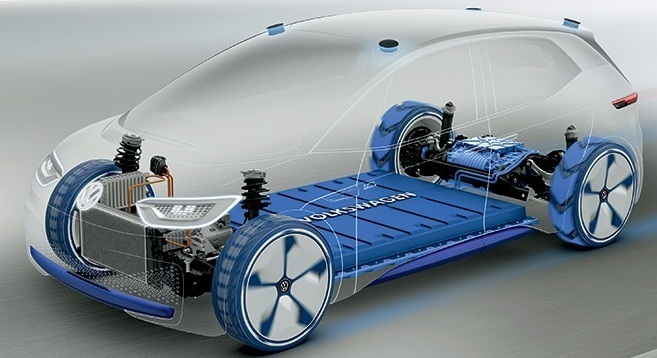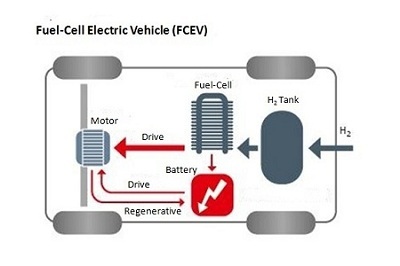
Types of Electric Cars and Working Principles
Types of Electric Cars
Different types of electric cars changed and are developed continuously giving users and potential users choices. Today the world is increasingly familiar with the terms BEV, HEV, PHEV and FCEV. How does an electric car work? How an electric vehicle works is depend on the type. This article will briefly discuss the types and working principles of electric cars or vehicles marketed in the World and Indonesia today.
An electric car is a vehicle that is fully or partially propelled by electric motors, using energy stored in rechargeable batteries. The first practical electric cars were produced in the 1880s. Electric cars were popular in the late 19th century and early 20th century. Innovation and advanced development in internal combustion engines (ICE) and mass production of cheaper gasoline vehicles has led to a decline in the use of electric vehicles.
———————————————
The development of energy storage technology, especially battery technology, makes electric cars become more popular again at this time. So how an electric car work really?
How Does An Electric Car Work? – General
When pedal of the car is pressed, then:
- Controller takes and regulates electrical energy from batteries and inverters
- With the controller set, the inverter then sends a certain amount of electrical energy to the motor (according to the depth of pressure on the pedal)
- Electric motor converts electrical energy into mechanical energy (rotation)
- Rotation of the motor rotor rotates the transmission so the wheels turn and then the car moves.
Note: The working principle above is for battery electric vehicle (BEV) type.
———————————————
Types of Electric Cars
There are 4 (four) types of electric cars, with the following outline:
- Battery Electric Vehicle (BEV)
- Hybrid
- Hybrid Electric Vehicle (HEV)
- Plug-in Hybrid Electric Vehicle (PHEV)
- Fuel Cell Electric Vehicle (FCEV)
In brief, the system architecture of the four types of electric cars above can be seen in the following figure:
You can read more detailed explanation below.
———————————————
Battery Electric Vehicle (BEV)
A Battery Electric Vehicle (BEV), also called All-Electric Vehicle (AEV), runs entirely on a battery and electric drive train. This types of electric cars do not have an ICE. Electricity is stored in a large battery pack that is charged by plugging into the electricity grid. The battery pack, in turn, provides power to one or more electric motors to run the electric car.
Architecture and Main Components of
 Components of BEV
Components of BEV
- Electric motor
- Inverter
- Battery
- Control Module
- Drive train
Working Principles of BEV
- Power is converted from the DC battery to AC for the electric motor
- The accelerator pedal sends a signal to the controller which adjusts the vehicle’s speed by changing the frequency of the AC power from the inverter to the motor
- The motor connects and turns the wheels through a cog
- When the brakes are pressed or the electric car is decelerating, the motor becomes an alternator and produces power, which is sent back to the battery
Examples of BEV
Volkswagen e-Golf, Tesla Model 3, BMW i3, Chevy Bolt, Chevy Spark, Nissan LEAF, Ford Focus Electric, Hyundai Ioniq, Karma Revera, Kia Soul, Mitsubishi i-MiEV, Tesla X, Toyota Rav4.
———————————————
Hybrid Electric Vehicle (HEV)
This type of hybrid cars is often called as standard hybrid or paralel hybrid. HEV has both an ICE and an electric motor. In this types of electric cars, internal combustion engine gets energy from fuel (gasoline and others type of fuels), while the motor gets electricity from batteries. The gasoline engine and electric motor simultaneously rotate the transmission, which drives the wheels.
The difference between HEV compared to BEV and PHEV is where the batteries in HEV can only charged by the ICE, the motion of the wheels or a combination of both. There is no charging port, so that the battery cannot be recharged from outside of the system, for example from the electricity grid.
Architecture and Main Components of HEV
 Components of HEV
Components of HEV
- Engine
- Electric motor
- Battery pack with controller & inverter
- Fuel tank
- Control module
Working Principles of HEV
- Has a fuel tank that supplies gas to the engine like a regular car
- It also has a set of batteries that run an electric motor
- Both the engine and electric motor can turn the transmission at the same time
Examples of HEV
Honda Civic Hybrid, Toyota Prius Hybrid, Honda Civic Hybrid, Toyota Camry Hybrid.
———————————————
Plug-in Hybrid Electric Vehicle (PHEV)
PHEV is a type of hybrid vehicle that both an ICE and a motor, often called as series hybrid. This types of electric cars offers a choice of fuels. This type of electric cars is powered by a conventional fuel (such as gasoline) or an alternative fuel (such bio-diesel) and by a rechargeable battery pack. The battery can be charged up with electricity by plugging into an electrical outlet or electric vehicle charging station (EVCS).
PHEV typically can run in at least two modes:
- All-electric Mode, in which the motor and battery provide all the car’s energy
- Hybrid Mode, in which both electricity and gasoline are employed.
Some PHEVs can travel more than 70 miles on electricity alone.
Architecture and Main Components of PHEV
 Components of PHEV
Components of PHEV
- Electric motor
- Engine
- Inverter
- Battery
- Fuel tank
- Control module
- Battery Charger (if onboard model)
Working Principles of PHEV
PHEVs typically start up in all-electric mode and operate on electricity until their battery pack is depleted. Some models shift to hybrid mode when they reach highway cruising speed, generally above 60 or 70 miles per hour. Once the battery is empty, the engine takes over and the vehicle operates as a conventional, non-plug-in hybrid.
In addition to plugging into an outside electric power source, PHEV batteries can be charged by an internal combustion engine or regenerative braking. During braking, the electric motor acts as a generator, using the energy to charge the battery. The electric motor supplements the engine’s power; as a result, smaller engines can be used, increasing the car’s fuel efficiency without compromising performance.
Examples of PHEV
Porsche Cayenne S E-Hybrid , Chevy Volt, Chrysler Pacifica, Ford C-Max Energi, Ford Fusion Energi, Mercedes C350e, Mercedes S550e, Mercedes GLE550e, Mini Cooper SE Countryman, Audi A3 E-Tron, BMW 330e, BMW i8, BMW X5 xdrive40e, Fiat 500e, Hyundai Sonata, Kia Optima, Porsche Panamera S E-hybrid, Volvo XC90 T8.
———————————————
Fuel Cell Electric Vehicle (FCEV)
Fuel Cell Electric Vehicles (FCEVs), also known as fuel cell vehicles (FCVs) or Zero Emission Vehicle, are types of electric cars that employ ‘fuel cell technology’ to generate the electricity required to run the vehicle. In this type of vehicles, the chemical energy of the fuel is converted directly into electric energy.
Architecture and Main Components of FCEV
 Components of FCEV
Components of FCEV
- Electric motor
- Fuel-cell stack
- Hydrogen storage tank
- Battery with converter and controller
Working Principles of FCEV
The working principle of a ‘fuel cell’ electric car is different compared to that of a ‘plug-in’ electric car. This types of electric cars is because the FCEV generates the electricity required to run this vehicle on the vehicle itself.
Examples of FCEV
Toyota Mirai, Hyundai Tucson FCEV, Riversimple Rasa, Honda Clarity Fuel Cell, Hyundai Nexo.
———————————————
Contact Omazaki Group for consultancy and planning to install EVCS in Indonesia for domestic, commercial and industrial purposes, and public EVCS as well. For training related to electrical vehicles (EV), please download the complete list and catalog at Omazaki Training.
Related Articles:
- Electric Car Components and Functions
- Electric Car Batteries and Characteristics
- Electric Vehicle Charging Station (EVCS)
- Wireless Electric Vehicle Charging Stations (WEVCS) Technology
References:
- https://www.caa.ca/electric-vehicles/types-of-electric-vehicles/#bev
- https://en.wikipedia.org/wiki/Electric_car
- https://www.seai.ie/technologies/electric-vehicles/what-is-an-electric-vehicle/types-of-electric-vehicle/
- https://www.evgo.com/why-evs/types-of-electric-vehicles/
- http://www.ieahev.org/about-the-technologies/plug-in-hybrid-electric-vehicles/
- Kenneth Barnett – The Hybrid Car: A look at the future of car
- https://www.conserve-energy-future.com/howelectriccarswork.php
- https://www.pkw-label.de/alternative-antriebe/elektrofahrzeuge-bevphevreev
- https://www.elektromobilitaet.nrw/infos/e-auto/?L=0


.jpeg)
